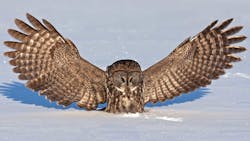Owl Wings Inspire Airfoil Design and Noise Suppression
A new sound-suppression study provides fresh insight for airfoil design and noise control for micro-aircraft and fluid machinery.
The research focused on the concept of trailing-edge noise by using the characteristics of owl wings to inform airfoil design and significantly reduce the trailing-edge noise.
Trailing-edge noise can be characterized as the dominant sound emitted from aeronautical and turbine engines, such as wind turbines and marine propellers, but are also prevalent in drones and automobile fans. Suppressing noise pollution from take-off and landing is a major environmental goal in urban areas. The FAA has set the day-night average sound level (DNL) 65 dBA as the threshold of significant noise exposure, below which residential land uses are compatible.
Noise—whether of the engine or aerodynamic variety—is a perpetual by-product of air travel and impels a continued review of noise mitigation at the source.
Researchers from Xi’an Jiaotong University, based in Xi’an, Shaanxi, China, had good reason to take their cue from nocturnal owls. “Nocturnal owls produce about 18 decibels less noise than other birds at similar flight speeds due to their unique wing configuration,” said Xiaomin Liu, a co-author of the paper, which is published in Physics of Fluids, by AIP Publishing. Moreover, Liu added, when the owl catches prey, the shape of the wings is also constantly changing, which underscores the significance of studying the wing edge configuration during owl flight.
What Exactly is Trailing-Edge Noise?
Trailing-edge noise is broadband sound. It is generated when airflow passes along the back of an airfoil, such as the wing or blades of the propeller, rotor or turbine. The flow forms a turbulent layer of air along the upper and lower surfaces of the airfoil. The researchers explain that when that layer of air flows back through the trailing edge, it scatters and radiates noise. It plays a significant role in the overall airframe noise.
Previous research on the effects of serrated trailing edges showed that serrations effectively reduce the noise of rotating machinery. But these studies also showed that noise reduction could not be generalized—the measure of noise diffusion depended on the final application.
“At present, the blade design of rotating turbomachinery has gradually matured, but the noise reduction technology is still at a bottleneck,” said Liu. “The noise reduction capabilities of conventional sawtooth structures are limited, and some new non-smooth trailing-edge structures need to be proposed and developed to further tap the potential of bionic noise reduction.”
Suppressing Noise in Rotating Machinery
The researchers used noise calculation and analysis software to conduct a series of detailed theoretical studies of simplified airfoils with characteristics reminiscent of owl wings. They applied their findings to suppress the noise of rotating machinery.
They found that they could suppress the noise when they improved the flow conditions around the trailing edge and optimized the shape of the edge. The researchers also pointed out that symmetric trail-edge serrations reduced the noise more so than conventional trailing-edge serrations.
Since the level of noise reduction was dependent on operating conditions, the researchers emphasized that the airfoil designs should be further evaluated based on the specific application.
For example, wind turbines have complex incoming flow environments, which require a more general noise reduction technology. The researchers said that examining noise reduction techniques under the influence of different incoming flows would make their conclusions more universal.
The owl wing research, noted the authors, will serve as an important guide for airfoil design and noise control.
The article “Aeroacoustic Investigation of Asymmetric Oblique Trailing-edge Serrations Enlightened by Owl Wings” was authored by Lei Wang and Xiaomin Liu. Read the full article in Physics of Fluids.
About the Author

Rehana Begg
Editor-in-Chief, Machine Design
As Machine Design’s content lead, Rehana Begg is tasked with elevating the voice of the design and multi-disciplinary engineer in the face of digital transformation and engineering innovation. Begg has more than 24 years of editorial experience and has spent the past decade in the trenches of industrial manufacturing, focusing on new technologies, manufacturing innovation and business. Her B2B career has taken her from corporate boardrooms to plant floors and underground mining stopes, covering everything from automation & IIoT, robotics, mechanical design and additive manufacturing to plant operations, maintenance, reliability and continuous improvement. Begg holds an MBA, a Master of Journalism degree, and a BA (Hons.) in Political Science. She is committed to lifelong learning and feeds her passion for innovation in publishing, transparent science and clear communication by attending relevant conferences and seminars/workshops.
Follow Rehana Begg via the following social media handles:
X: @rehanabegg
LinkedIn: @rehanabegg and @MachineDesign
